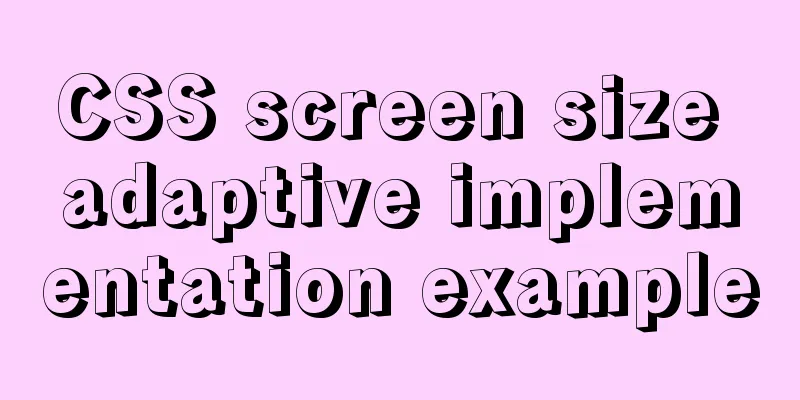Detailed explanation of Vue parent-child component value transfer and one-way data flow issues

PrefaceWe know that the core concept of parent-child components in Vue is the one-way data flow problem, and props are passed in one direction. So what exactly is the unidirectional data flow problem? This article summarizes the study notes on this knowledge point. 1. Parent component passes value to child component
<div id="app">
<blog-item :title="title"></blog-item>
</div>
// Define subcomponent Vue.component("blog-item", {
props: ['title'],
data() {
return {
}
},
template: "<p>{{title}}</p>"
})
// Define the parent component new Vue({
el: "#app",
data() {
return {
title: "msg",
}
},
})The parent component passes the value to the child component through :title = "title". The child component receives the value of the parent component through props and then renders it on the page through an interpolation expression. 2. Subcomponent props type constraint problemCommon type constraints are as follows:
props: {
title: String,
likes: Number,
isPublished: Boolean,
commentIds: Array,
author: Object,
callback: Function,
contactsPromise: Promise // or any other constructor
}In addition to the common types above, Vue also provides constructors and custom functions to customize the types of child component props. (1) Constructor custom type
//Custom function common to both components function Person (firstName, lastName) {
this.firstName = firstName
this.lastName = lastName
}
//Use Vue.component('blog-post', {
props: {
author: Person
}
//Used in parent component var obj = new Person("1","2")
<blog-post :author='obj'></blog-post>In the above code, we first define a public custom constructor, which can be used to create an object. The instance object has two properties, firstName and lastName. In the parent component, we call the constructor to create an obj instance and pass it to the child component. The child component defines a prop of the constructor type to receive the object. (2) Custom functions and custom types
// Custom function Vue.component('blog-post', {
props: {
propsA: String, //Must be a string type propsB: [String, Number], //Multiple optional types propsC: {type: Number, default: 100}, //Define the type and set the default value //Custom validation function propsD: {
validator: function (value) {
// This value must match one of the following strings return ['success', 'warning', 'danger'].indexOf(value) !== -1
}
}
}Vue provides a very flexible way to define the type of parameters received by child components. In the above code, a custom validation function is used to constrain the value type in the parent component. 3. One-way data flow problemOne-way data flow is the core concept of parent-child components in Vue, and props are bound one-way. When the property value of the parent component changes, it will be passed to the child component for corresponding changes, thus forming a one-way downward binding. The property change of the parent component will flow to the downstream child component, but conversely, in order to prevent the child component from accidentally modifying the data in the parent component and affecting the status of other child components, Vue stipulates that data flow from bottom to top is not allowed. When the property of the parent component changes, it will be passed to the child component, but the property change of the child component will not affect the parent component. In this case, you may feel that props is a bit useless. It can only be used when initializing the component and cannot be operated in the child component. Therefore, when we use it, we often have two ways to operate props: (1) define a local variable and initialize it with props, and then operate this local variable. (2) Define a computed property, process props and return it.
<div id="app">
<blog-item :title="title1"></blog-item>
<blog-item :title="title2"></blog-item>
<blog-item :title="title3"></blog-item>
<hr>
<button @click='toclick'>Click me</button>
</div>
// Define subcomponent Vue.component("blog-item", {
props: ['title'],
data() {
return {
}
},
template: "<p>{{title}}</p>"
})
// Parent component new Vue({
el: "#app",
data() {
return {
title1: "111",
title2: "222",
title3: "333"
}
},
methods: {
toclick() {
this.title3 = "000"
}
}
})
<div id="app">
<blog-item :title="title"></blog-item>
</div>
// Define subcomponent Vue.component("blog-item", {
props: ['title'],
computed: {
computedTitle() {
return "computedTitle" + this.title
}
},
data() {
return {
subTitle: "subTitle" + this.title
}
},
template: "<p>{{title}}==={{subTitle}}==={{computedTitle}}</p>"
})
// Parent component new Vue({
el: "#app",
data() {
return {
title: "111",
}
},
})
SummarizeThis is the end of this article about the value transfer between parent and child components of Vue and the one-way data flow problem. For more relevant content about the value transfer between parent and child components of Vue and the one-way data flow, please search for previous articles on 123WORDPRESS.COM or continue to browse the related articles below. I hope you will support 123WORDPRESS.COM in the future! You may also be interested in:
|
<<: MySQL database operations (create, select, delete)
>>: Windows DNS server exposed "worm-level" vulnerability, has existed for 17 years
Recommend
Linux /etc/network/interfaces configuration interface method
The /etc/network/interfaces file in Linux is used...
Solution to EF (Entity Framework) inserting or updating data errors
Error message: Store update, insert, or delete st...
Docker image creation and one-click packaging and deployment of the entire project
Introduction to common Dockerfile instructions in...
Example of how to implement a 2-column layout in HTML (fixed width on the left, adaptive width on the right)
HTML implements 2-column layout, with fixed width...
Sample code for implementing image drawer effect with CSS3
As usual, let’s first post the picture effect: Th...
Detailed explanation of the solution to keep the content within the container in flex layout
On the mobile side, flex layout is very useful. I...
Simple implementation of html hiding scroll bar
1. HTML tags with attributes XML/HTML CodeCopy co...
Detailed explanation of Nginx process scheduling problem
Nginx uses a fixed number of multi-process models...
Solution to the 404/503 problem when logging in to TeamCenter12
TeamCenter12 enters the account password and clic...
Web page CSS priority is explained in detail for you
Before talking about CSS priority, we need to und...
MySQL database account creation, authorization, data export and import operation examples
This article describes the examples of creating a...
Five practical tips for web form design
1. Mobile selection of form text input: In the te...
Detailed explanation of the example of exporting data from a specified table in MySQL
Detailed explanation of MySQL exporting data from...
Detailed installation and configuration tutorial of PostgreSQL 11 under CentOS7
1. Official website address The official website ...
MySQL implements increasing or decreasing the specified time interval for all times in the current data table (recommended)
The DATE_ADD() function adds a specified time int...











